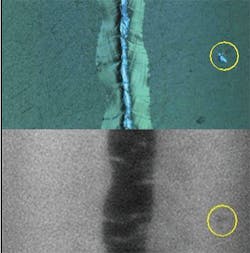Vision robot inspects accelerator cavities
The International Linear Collider is a proposed electron-positron collider that will complement the Large Hadron Collider (LHC), a proton-proton collider at the European Center for Nuclear Research (CERN) in Geneva, Switzerland.
Inside the collider, superconducting accelerator cavities operating at temperatures near absolute zero provide the particles with an increasing amount of energy until they collide at the centre of the machine.
To optically inspect the surface structures of those cavities, engineers at Deutsches Elektronen-Synchrotron (DESY; Hamburg, Germany) have developed a fully automated robot. The so-called Optical Bench for Automated Cavity inspection with High resolution and short Timescales (OBACHT) robot uses linear and rotational drives to position a camera inside the cavity.
The high-resolution "Kyoto" camera itself -- which was developed in a collaborative effort between Kyoto University (Kyoto, Japan) and KEK, a high energy accelerator research organization in Japan -- then captures 3488×2616 pixel images of the surface of the cavities, resolving features down to 5μm.
The power of the technique can be seen in the image above, which contrasts a high-resolution image of a welding seam and a potential defect with an earlier image from approximately the same area taken with a boroscope typically used to examine the quality of the welding seam.
The entire automated inspection procedure takes about 10 hours. To date, the system has been used to inspect 11 accelerator cavities.
The researchers recently presented a technical paper describing the development of the image processing system at the International Particle Accelerator Conference (IPAC) 2012 (New Orleans, LA). It can be found here.
Past articles on welding from the Vision Systems Design archives that you might also find of interest.
1. Smart sensors control laser welding connections
Engineers at the Fraunhofer Institute for Physical Measurement Techniques (IPM; Freiburg, Germany) have developed a machine-vision system to detect and measure the penetration hole of a weld and provide feedback based on the results.
2. X-rays enable weld inspection
MicroView & LingZhi Image Technology have developed a system specifically for weld inspection.
3. Laser-light sensor directs robotic-vision weld positioning
Azure (Dorchester, Dorset, England) has developed a noncontact vision sensor to monitor the position of a welding seam relative to the welding torch and feed the information to a robotic position controller.
-- Dave Wilson, Senior Editor, Vision Systems Design
